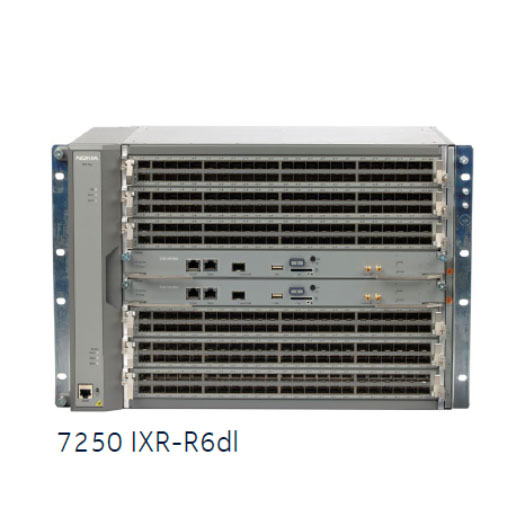Nokia 7250 IXR-R6dl
Interconnect Router R-series
Using Nokia 7250 IXR-R6dl routers, service providers can rapidly create and deploy new services while extending the lifetime of their existing infrastructure investment. Public and private enterprises can efficiently expand their aggregation networks
The Nokia R-series 7250 IXR-R6dl Interconnect Router offers high port density in compact, modular, extended-temperature form factors. Routers inthis series are ideal for IP anyhaul, aggregation, fixed-mobile convergence and mission-critical applications.
Nokia 7250 IXR-R Interconnect Routers
The 7250 IXR-R series supports new 5G transport requirements. It delivers low latency for fronthaul, Internet of Things (IoT) and mission-critical applications while providing a large buffer memory for less delay-sensitive applications.
Per-service queuing features support differentiated quality of service (QoS), which is ideal for any-G aggregation and fixed-mobile network convergence. These features also help industrial enterprises attain IT/OT convergence by simultaneously carrying both their business and operational traffic.
Network operators who upgrade to the 7250 IXR-R series today will be ready to meet new service demands for many years to come.
Features & Benefits
- To simplify and automate network operations, the 7250 IXR enables model-driven network management features through the Nokia SR OS and is managed by the Nokia Network Services Platform (NSP). The NSP offers a rich set of service management features that automates new service delivery and reduces operating cost. Standards-based software-defined networking (SDN) interfaces enable best-path computation to be offloaded to SDN controllers such as the Nokia NSP. 7250 IXR-R-series routers, operating as path computation clients (PCCs), collect and report perlink and per-service delay, jitter and loss metrics together with port utilization levels, for efficient path computation by a path computation element (PCE) function in the SDN controller.
- The modular architecture used by routers in the 7250 IXR-R series supports a variety of deployment options. High-density 1GE/10GE/25GE/40GE/ 100GE media-dependent adapter (MDA) cards accommodate future growth. CFP2 DCO optics provide high bandwidth over extended distances, lowering the total cost of operations. Legacy interface cards support transport over existing TDM interfaces and allow for seamless migration to a next-generation IP/MPLS infrastructure. Side-to-side airflow with a fan filter and redundant fans increases system lifetime and reduce maintenance costs. Side-to-side airflow also guarantees compatibility with 300 mm ETSIcompliant cabinets. This capability is typically not available with front-to-back cooled systems
- The 7250 IXR-R series offers industry-leading control-plane performance using a multi-tasking, multi-priority operating system to take full advantage of multi-core processors combined with symmetrical multiprocessing (SMP). Network operators benefit from faster convergence times and powerful operations, administration and maintenance (OAM) and security features.
- The 7250 IXR-R series provides precise timing and accurate synchronization to meet the stringent requirements of 4G/5G mobile base stations and other networks. It improves timing accuracy over packet networks by combining built-in architectural features with Global Navigation Satellite System (GNSS) capabilities, ITU-T Synchronous Ethernet (SyncE) and the Nokia Bell Labs IEEE 1588v2 algorithm. Powerful QoS mechanisms deliver best-in-class performance by minimizing the delay and delay variation experienced by packet synchronization technologies. Port-based timestamping delivers consistently accurate IEEE 1588v2 performance.
- Granular, in-depth and scalable per-service monitoring offers visibility into packet flows. The 7250 IXR-R series provides comprehensive reporting on key performance indicators such as packet discard and forward counters. These capabilities improve reliability and help service providers fulfill service-level guarantees. Industry, enterprise and public sector operators can ensure that their critical operations traffic is receiving the required treatment. The 7250 IXR-R series provides excellent protection against link or equipment failures through control and datapath redundancy options. It quickly reroutes traffic and re-converges networks using a robust set of dynamic routing and recovery capabilities. Superior network resiliency reduces network downtime and improves the overall productivity of network operations. With a highly resilient network, network operators can reduce operating costs, improve enduser satisfaction and offer higher-value SLAs.
- The 7250 IXR-R series, with its extended temperature range, mechanical hardening and robust EMC design, meets the IEEE 1613, IEC 61850-3 and EN 50121-4 standards for power substation and railway environments. For uncertain environmental conditions, PCB enhanced plating (PEP) is included on the 7250 IXR-R6, IXR-R6d and IXR-R6dl to provide robustness without the need for conformal coating.
Automation
Network longevity
High performance
Accurate timing
Reliable service delivery
For harsh environments
Software Features
- Point-to-point Ethernet pseudowires/virtual leased line (VLL)
- Ethernet Virtual Private Network (EVPN)
- Virtual Private Wire Service (EVPN-VPWS)
- Virtual Private LAN Services (EVPN-VPLS): IPv4 and IPv6 support, including Virtual Router Redundancy Protocol (VRRP)
- Multihoming with single active or active/active modes
- Multipoint Ethernet VPN services with VPLS based on Targeted Label Distribution Protocol (T-LDP)and Border Gateway Protocol (BGP)
- Routed VPLS with Internet Enhanced Services(IES)/IP-VPN IPv4 and IPv6
- Ingress and egress VLAN manipulation for L2 services
- IP VPN Virtual Private Routed Network (VPRN), Inter-Autonomous System (Inter-AS) Option A, B and C
- IPv6 VPN Provider Edge (6VPE)
- EVPN Interface-less IPv4 and IPv6 prefix routes (EVPN-IFL)
- MPLS (including SR-MPLS) to SRv6 interworking GW
- Segment Routing MPLS (SR-MPLS)
- Intermediate System-to-Intermediate System (SR-ISIS) and Open Shortest Path First(SR-OSPF)
- Traffic engineering (SR-TE) IPv4, IPv6
- Segment Routing IPv6 (SRv6)2
- SRv6 IS-IS shortest path tunnel support in MT=0 and MT=2
- Flexible Algorithms
- Admin-group include/exclude, IGP/TE/Latency metric
- MPLS label edge router (LER) and label switching router (LSR) functions
- LDP
- Resource Reservation Protocol with traffic engineering (RSVP-TE)
- BGP Labeled Unicast (LU) (RFC 3107) route tunnels
- IP routing
- Dual-stack Interior Gateway Protocol (IGP)
- Multi-topology, multi-instance IS-IS
- Multi-instance OSPF
- Multiprotocol BGP (MP-BGP)
- BGP-LU support in edge, area border router (ABR) and autonomous system boundary router (ASBR) roles
- Usage-triggered download of BGP label routes to Label - Forwarding Information Base (L-FIB)
- Accumulated IGP (AIGP) metric for BGP
- BGP monitoring protocol (BMP)
- BGP route-reflector for EVPN and IP-VPN with VPNv4 and VPNv6 address families (AFs)
- BGP confederations
- IGP and BGP shortcuts
- Layer 3 Multicast – base routing
- Internet Group Management Protocol (IGMP)
- Protocol Independent Multicast – Sparse Mode (PIM-SM), Source Specific Multicast (SSM)
- Multicast Listener Discovery (MLD)
- Layer 3 Multicast - VPRN
- Next-generation multicast VPNs (NG-MVPN)
- SSM with multicast LDPv4 (mLDPv4)
- IGMP/MLD
- IGMP/MLD on Routed VPLS Interface
- Layer 2 Multicast
- IGMP/MLD snooping
- SR-TE LSPs, RSVP-TE LSPs
- PCC initialized, PCC controlled – PCC initialized, PCE computed
- PCC initialized, PCE controlled
- SR-TE LSPs: PCE initialized, PCE controlled
- SR policy: BGP and static
- Topology discovery: BGP-Link State (BGP-LS) IPv4 and IPv6
- Telemetry: streaming interface statistics, service delay and jitter metrics
- Netflow/cflowd
- IEEE 802.3.ad Link Aggregation Group (LAG) and multi-chassis (MC) LAG
- Pseudowire and LSP redundancy
- Control plane high availability (HA)
- BGP Edge and Core Prefix Independent Convergence (BGP PIC)
- HA routing and forwarding (excluding 7250 IXR-R4)
- Fast reroute:
- LDP with loop-free alternate (LFA) and remote loop-free alternate (rLFA) policies
- RSVP-TE
- Segment routing with rLFA and topology independent LFA (TI-LFA) in both SR-MPLS and SRv62
SDN
Load balancing and resiliency
- IP, SRv62 and MPLS load balancing by equal-cost multipath (ECMP)
- Weighted LAG hash
- VRRP
- Ethernet Ring Protection Switching ITU-T G.8032v2 (7250 IXR-R4/R6)
- Configurable polynomial and hash seed shift
- Entropy label (RFC-6790)
- In-service software upgrade (ISSU) (7250 IXR-R6)
- Ethernet IEEE 802.1Q (VLAN) and 802.1ad(QinQ) with 9k jumbo frames (7250 IXR-R4/R6) and 9.8K jumbo frames (7250 IXR-R6d/R6dl)
- Detailed forwarded and discarded counters for service access points (SAPs) and network interfaces in addition to port-based statistics
- High-scale, per-Virtual Output Queue (VoQ) packet and byte counters (7250 IXR-R6)
- High-scale, per-policer, detailed counters on a per-state basis
- VLAN range-based SAPs
- Dynamic Host Configuration Protocol (DHCP) server for IPv4 IES, VPNv4
- DHCP relay, IPv4 and IPv6, IES, IP-VPN, EVPN-VPLS
- Accounting records
- Hierarchical QoS (H-QoS)
- Hierarchical egress schedulers and shapers per forwarding class, SAP, network interface, port, or LAG
- Port sub-rate
- Intelligent packet classification, including media access control (MAC), IPv4, IPv6 match-criteriabased classification
- Granular rate enforcement with up to 32 policers per SAP/VLAN including broadcast, unicast, multicast and unknown policers
- Hierarchical policing for aggregate rate enforcement
- Strict priority, weighted fair queuing schedulers
- Congestion management via weighted random early discard (WRED)
- Egress marking or re-marking
- Simple Network Management Protocol (SNMP)
- Model-driven (MD) management interfaces
- NETCONF
- MD CLI
- Remote Procedure Call (gRPC)
- Comprehensive management with Nokia NSP
- IEEE 802.1ag, ITU-T Y.1731: Ethernet Connectivity Fault Management (CFM) for both fault detection and performance monitoring, including delay, jitter, and loss tests
- Ethernet bandwidth notification (ETH-BN) with egress rate adjustment
- Y.1564 SAT
- ETH-CFM LBM Responder
- IEEE 802.3ah: Ethernet in the First Mile (EFM)
- Bidirectional Forwarding Detection (BFD) IPv4, IPv6
- Micro-BFD - per member link (7250 IXR-R4/R6)
- Two-Way Active Measurement Protocol (TWAMP), TWAMP Light for base and flex-algo topologies
- A full suite of MPLS OAM tools, including LSP and virtual circuit connectivity verification (VCCV) ping
- Service assurance agent
- Mirroring with slicing support
- Port
- VLAN
- Filter output: MAC, IPv4/IPv6 filters
- Local/remote
- Port and VLAN loopback with MAC-swap
- Configuration rollback
- Zero Touch Provisioning (ZTP) capable
- Remote Authentication Dial-In User Service (RADIUS), Terminal Access Controller Access Control System Plus (TACACS+), and comprehensive control plane protection capabilities
- MAC, IPv4/IPv6 filters and criteria-based classifiers
- Per-port MAC security (MACsec)
- Secure Shell (SSH)
The 7250 IXR-R series supports, but is not limited to, the following features.
Services
Network protocols
Platform
QoS and traffic management
System management
Operations, administration and maintenance
Security







